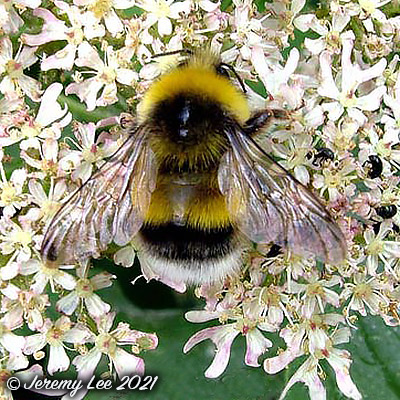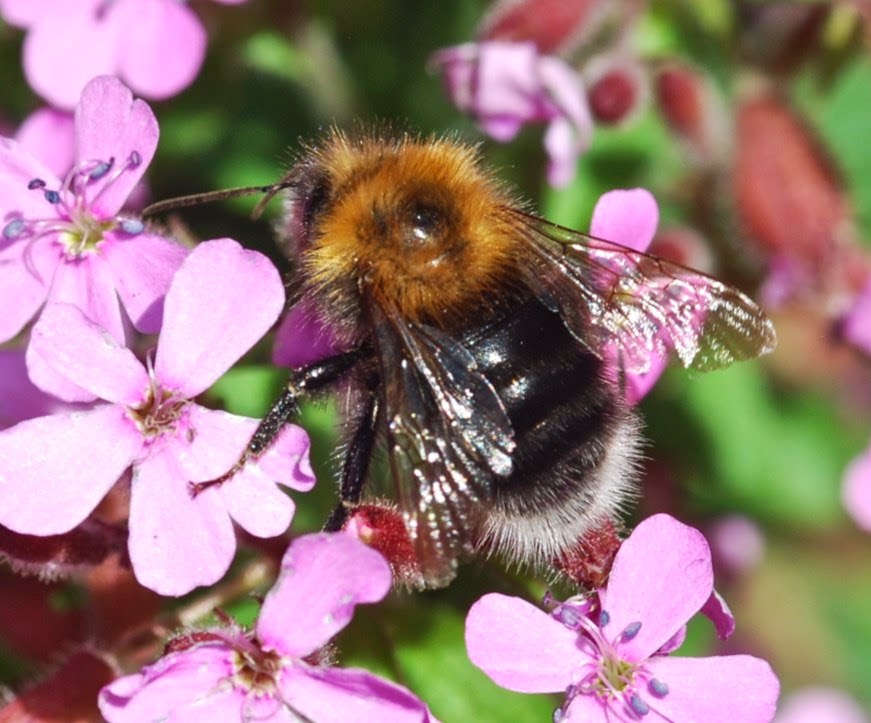In the last 80 years bumblebee populations in the UK have crashed: two species have become nationally extinct and several others have declined dramatically. Bumblebees are not only familiar and much-loved insects, but they are also essential for pollinating crops and wildflowers. The Bumblebee Conservation Trust is one organisation set up to address these concerns, and images to aid identification of bumblebees can be found here on its website.
Thanks to Ben Jones for this very informative article on the varieties of bees we can expect to see in our surroundings.
Bees
Bees evolved
from wasps about 100 million years ago to feed on flowering plants. Today there
are over 20,000 species - but in Woodbury Salterton you certainly won't see that
many different species. Unlike a lot of insects, bees use both sets of wings
simultaneously to fly, which requires a lot of energy.
Bumblebees
The
Bumblebee is the largest type of bee, with the earliest appearing in February. It will usually nest in underground holes or grass tufts, making a nest of only
a few dozen cells. Workers can number anywhere between 20 to over 200, and they forage for nectar and pollen provided by flowering plants. During the summer
months, the queen bee will produce a pheromone that stops her worker bees from
mating and laying eggs. The queen stops producing this pheromone near the end
of summer when the hive's food source (flowers) begins to run out. Only fertile
queen bees will survive the winter: worker or drone bees will die off as the
nest enters a period of anarchy in the Autumn, when the queen loses control of
the workers.
The first bumblebees to appear are the Early Bumblebee or Bombus pratorum, which can be identified by the red tail and the two yellow stripes located (one) in front of and (one) behind the wings. Queens of this species also have yellow stripes and are bigger than the worker bees. Males of this species can be identified by their yellow heads, as well as similar markings to the Queen and Worker Bee.
| A Queen Early Bumblebee (above) and different members of the species (below) |
Another species that appears in February is the White-tailed Bumblebee or Bombus Lucorum. The male of this species also has a yellow head but, unlike the Early Bumblebee, has a white tail.
 |
White-tailed Bumblebee male (above), and members of the species (below) |
This
species should not be mistaken for the Buff tailed Bumblebee or Bombus terrestris. The queen of this
species is the only truly buff tailed bee, as well as being one of the largest
Bumblebee queens. Her species is one of the most commonly seen in Britain, appearing
around the beginning of summer. Worker Bees of both species are completely
identical, although the white tailed Bumblebee will have a thicker yellow rear
band.
 |
Queen Buff-tailed bumble bee (above) and members of species (below) |
The Brown
tailed Bee species: these are unlikely to be seen in the local area but can be identified
by the brown hairs covering their bodies. The most commonly seen species is the
Common Carder Bee or Bombus Pascorum,
which has a Brown body and black tail with no stripes.
 |
| Queen Common Carder bee |
The Tree Bumblebee or Bombus Hypnorum: In the South
West we are also likely to see this newly arrived type of bumblebee, not native to the UK and
therefore an invasive species. Invasive species are not necessarily bad as they
may just fill in gaps as pollinators left by native species (whether they are a
benefit to Britain is yet to be determined). So far this species has been spotted as far north as
Glasgow and is thought to be spreading at a rate of 12,500 sq km per year
(that's 4,500 sq miles). It was first spotted in the UK in 2001. It can also be
found in the Arctic Circle, mainland Europe and Asia.
 |
| Records of Tree Bumblebee in the UK in 2014 |
The Tree
Bumblebee has an orange head and a white tail. They predominately favour woodland clearings, meaning that gardens make an excellent habitat.
 |
| Tree bumblebee |
Queens will nest in bird boxes or tree hollows although they are known for their entrepreneurial spirit: some have even been found nesting in tumble drier vent pipes. If this does happen, make sure someone with bee-keeping skills removes the nest. Any information on these nests should also be passed to the Bumblebee Conservation Trust.
 |
| Tree bumblebee nest in tumble drier vent pipe |
As the name suggests, Tree Bumblebees prefer nesting above ground. Nests can number up to 400 bees, and male bees will often display outside the nest for the new queens.
Workers will be in and out of the nest into dusk, operating far later than native species. They will also cover the outside of the nest in yellow poo and are more resistant to certain types of parasites than native bees.
It is
unlikely that you will detect a nest until it is about to collapse, which will
be when the number of bees has peaked. At this time drone bees are likely to
hover outside the nest in what is known as nest surveillance, which is
preparation for mating and part of the Tree bumblebees life-cycle. When new Queens
fly out of the nest, pairs of bees will fall to the ground and stay linked
together for a considerable amount of time.
 |
| Tree bumblebee nest surveillance flight |
If a nest is spotted, the best thing to do is leave it alone and notify BWARS (Bees, Wasps and Ants Recording Society) online. The bees are likely to leave within the next few months, although like some other bee species new queens may set up new nests in September.
Nests in bird
boxes are especially vulnerable to any vibrations. Bees may suddenly fly out if
disturbed, and sting people in the vicinity. The stings won't be too dangerous
as there not barbed.
Thanks to the Bumblebee Conservation Trust website for the images and much of the information,
and to resident Ben Jones for pulling them together for this article.


No comments:
Post a Comment